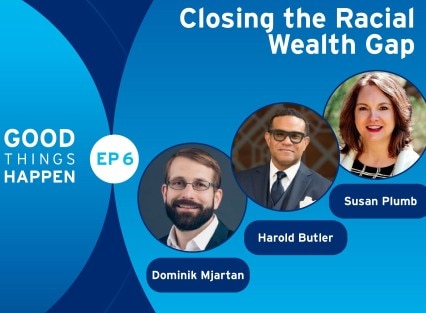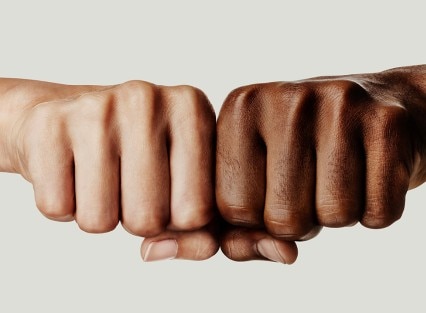In the city’s Greenwood District, sturdy two-and-three-story red brick buildings housed offices for doctors and lawyers, along with bustling storefronts with grocers, clothing stores, beauty salons, night clubs and theaters. This hub of locally driven economic activity was nationally known as Black Wall Street.
Then, in May of 1921, a white mob attacked the neighborhood and burned it to the ground. Thousands were left homeless, and hundreds injured or dead. In one of the worst domestic terror attacks in our nation’s history, Black Wall Street was annihilated, along with what should have been a foundation of generational wealth.
Historical Black Wall Street may be a memory, but its inspiring legacy endures. Today a new generation of Black business owners and Black-owned banks, known as Minority Depository Institutions (MDIs), are working to create a New Black Wall Street.
New Black Wall Street is a movement with a goal of opening up equitable access to capital to communities of color, supporting Black-owned businesses and helping to close the racial wealth gap.
“When I think about Black Wall Street it’s all about parity,” says Harold Butler, head of Citi’s Diverse Financial Institutions Group. “It's about access to opportunities and access to capital so that Black businesses can compete fairly in the marketplace.”
Breaking down the barriers to capital
The systemic obstacles to greater financial mobility for communities of color are clear. A 2020 analysis by Citi of four key areas — wages, housing, education and investment — found that inequities for Black Americans have cost the U.S. economy up to $16 trillion over the past 20 years.
|
The good news? That same report found that immediate action can make a meaningful difference. Specifically, if the racial wealth gaps for Black Americans across those four areas were closed today, $5 trillion could potentially be added to the U.S. GDP over the next five years. In September 2020, Citi committed $1 billion to an Action for Racial Equity to help provide better access to banking and credit in communities of color; invest in Black-owned businesses; expand affordable housing and homeownership for Black Americans; and advance anti-racist practices within Citi and the financial services industry. “Citi really was the vanguard in analyzing the racial wealth gap and how damaging the racial wealth gap has been, not just for Black people, but for the entire country,” says Robert E. James, Jr., director of strategic initiatives, president, Carver Development CDE. “And they made a commitment to do something about it.” |
Robert James II, director of strategic initiatives, president, Carver Development CDE - Photo courtesy of Somi Studios, Savannah |
Butler points out that in Black communities, capital is often only available through trusted local Black banks or MDIs. Unfortunately, just as Black business owners have historically faced higher barriers to capital, Black-owned banks have also lacked equitable access to capital. Which is why, as part of Citi’s Action for Racial Equity commitment, $100 million was allocated to support MDI growth and revenue generation.
Citi has collaborated with more than 16 Black-owned banks including Optus Bank, OneUnited Bank and Carver State Bank. “They may be small, but they're mighty,” says Butler. “And they're very mission-oriented.”
Supporting the next generation of Black entrepreneurs
MDIs are mission-driven by design. Savannah, GA-based Carver State Bank was founded in 1927 by Black entrepreneur and commercial real estate broker Louis B. Toomer to help fill the need for a private bank and real estate investment company for the Black community.
|
“There are just so many Black-owned businesses in Savannah that never would have had a chance but for Carver,” says James, “We really are a critical, key part of that legacy. And we’re really looking forward to being a key part of the new generation of Black entrepreneurship.” One thing that stands out about Citi’s alliance with each of its partner MDIs is that it is left to the MDIs to decide how to allocate resources in order to grow and scale. For Carver State Bank, that means strengthening technology to improve how they deliver services and continue to make good on the bank’s strategic mission. |
 |
“We have four strategic building blocks: to build money, build homes, build communities and build businesses,” says James. “Everything we do is focused on those four building blocks which, if we can implement them over the next several years, will help to reduce the racial wealth gap.”
As the country’s largest Black-owned bank and first Black-owned internet bank, OneUnited Bank is expanding the products and services it offers for the digital age. “Citi recognizes the importance of building a future for Black people and Black businesses,” says Kevin Cohee, president and CEO of Boston-based OneUnited Bank. “We want to make sure that we build businesses that are larger in scope — that's our challenge and our opportunity — as we move into this technology-driven society.”
|
Columbia, SC-based Optus Bank is leveraging Citi’s mentorship and network so that it, in turn, can offer an improved level of service to spend more time with clients to meet their unique needs. “Part of the challenge is that access to financial capital is not the entire solution,” says Dom Mjartan, president and CEO of Optus Bank. “It's also access to human capital and social capital that takes an entrepreneur from a likelihood of failure to a likelihood of success.” Their shared goals of these MDIs are to strengthen Black communities through wealth generation. What will it take for America’s MDIs to reach their full potential impact? “They just need access to the same markets as everybody else,” says Butler. “They need companies and industry to not treat them as if they're a credit risk,” says Butler. “It's not about the leadership of the banks. It's all about the access to capital and just leveling the playing field for them to be able to be competitive like everybody else.” |
Dominik Mjartan, president and CEO, Optus Bank — Photo courtesy of Jeff Blake |
In addition to the creation of Citi’s Diverse Financial Institutions Group, Citi supports MDIs with mentorship, training and access to professional networks. The MDI Rotational Program, a first-of-its-kind initiative, embeds Citi executives within MDIs for up to a year to share expertise and help grow the MDI’s business. The bank has also launched an online lending program, Bridge Built by Citi℠, which services small -to-medium sized businesses using various regional, local and community banks, including MDIs, as the primary agents of transactions.
“We're not asking for a handout. We're asking for a partnership,” says Cohee. “We're looking for ways to strengthen Black America — we do that through working with Black Americans and their allies. And Citi is one of our most important allies.”
King Williams is a journalist and documentary filmmaker based in Atlanta, GA.
The content reflects the view of the author of the article and does not necessarily reflect the views of Citi or its employees, and we do not guarantee the accuracy or completeness of the information presented in the article.





